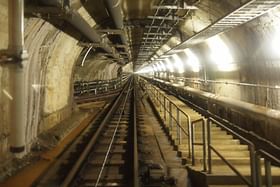The entire 21 km stretch will be constructed using a combination of two techniques – New Austrian Tunnelling Method (NATM) and Tunnel Boring Machine (TBM).
The undersea tunnel proposed for the Mumbai-Ahmedabad Bullet Train will ensure conservation of approximately 12 hectares of mangrove forests and the protection of Flamingo Sanctuary in the Thane Creek.
The 21 km tunnel will be built between Mumbai’s Bandra Kurla Complex (BKC) station and Kalyan Shilphata, in Maharashtra.
Of the tunnel’s length, seven km would run under the Thane creek, which is home to a wide variety of rare flora and fauna. About 1.8 km of this tunnel will be constructed under the sea bed, while the remaining part would lie under the mangroves on either side of creek.
With an effort to conserve the ecologically sensitive zone, the process of the undersea tunnel will escalate the construction cost of the 21 km long corridor from estimated Rs 100 crore to Rs 10,000 crore.
The Thane creek spans a length of 26 km. It is an inlet along the shoreline of the Arabian Sea that isolates the city of Mumbai from the Indian mainland.
The east bank lies in the Thane and Navi Mumbai districts, while the west bank is in the Greater Mumbai district. The water body is fed by numerous freshwater sources and is covered with mangroves on both sides.
A significant portion of the creek has been designated as the Thane Creek Flamingo Bird Sanctuary (TCFS). It is a very important wintering ground for waterbirds and supports over 100,000 birds.
The National High Speed Rail Corporation Limited (NHSRCL) had appointed Central Institute of Mining and Fuel Research (CIFMR) to conduct a study on the effect of the underwater tunnel on the birds and the mudflats, which are the feeding areas for these migratory birds.
The study showed tunnelling can be carried out without any disturbances to the mudflats in the creek at a depth of 20-25 metres.
The construction of the undersea tunnel will be a massive challenge as it will involve two Tunnel Boring Machines (TBMs) which will meet half way under the sea to join both parts by a process called docking.
The entire 21 km stretch will be constructed using a combination of two techniques – New Austrian Tunnelling Method (NATM) to carve out 5 km of the tunnel and Tunnel Boring Machine (TBM) for the remaining 16 km.
The tunnel will be a single tube with 13.2 meters in width to accommodate both up and down tracks. It will be about 25-65 meters deep on average from the ground level, while the deepest construction point will be 114 m below the Parsik hill near Shilphata.
In September 2022, the NHSRCL invited bids for the tunnelling works. Leading engineering firm Larsen & Toubro and Afcons Infrastructure are in the race to bag the prestigious project.
Additionally, the Bombay High Court on 9 February 2023, dismissed the petition brought by Godrej and Boyce Manufacturing Company Limited challenging the Maharashtra government’s grant of Rs 264 crore in compensation for acquiring its land for the project.
Moving forward, the court order has now resulted in 100 per cent completion of land acquisitions for the project. One of the entry points to the underground tunnel is located on the land owned by Godrej & Boyce Manufacturing Company Limited.
The Mumbai – Ahmedabad High-Speed Rail project is a 508.17 km long rail corridor that will connect Mumbai and Ahmedabad through 12 stations. The estimated cost of the project is Rs 1.1 lakh crore.


